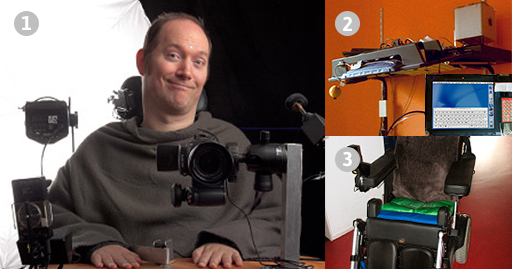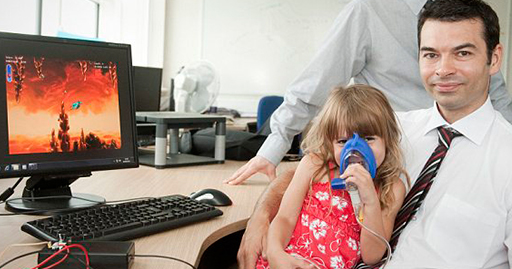Announcement
of the Winners of the
2nd Patient Innovation
Awards
A statement from
the Patient Innovation Advisory Board
"Patient Innovation (PI) empowers patients, caregivers, and
collaborators by giving them a place where they can share
their solutions. The PI Awards has been established to
celebrate the innovators from our community who stood out
with the impact and novelty of their solutions. In the first
edition of PI Awards we had six winners. This year, we faced
a new challenge of analyzing more than 300 new solutions and
reward the ones who, although suffering, find the strength
to overcome their health problems and innovate. That’s what
is inspiring us all. We selected seven innovators for the
2nd edition
of PI Awards. They win the laurels for innovating, sharing
and improving lives while facing adversity and challenges."
Warm congratulations to all winners.
We’re proud of you.
|

And the Winners are
|
• • •
Patient Innovation Category • • •
|
-
Michael Seres (UK)
|
Condition:
|
Crohn's disease
|
|
Innovation:
|
Ostom-I™
|
-

-
Michael Seres was diagnosed with Crohn’s disease at
the age of 12. After several surgeries, and
intestinal failure, he underwent a small bowel
transplant at The Churchill Hospital in Oxford.
After an ileostomy he was given a stoma, in 2011,
when he was 41, which is a surgical procedure where
the small bowel is diverted through an opening in
the abdomen. The opening is known as a stoma, from
where his digestive content leave the body through a
medical bag called ostomy bag. He had no control of
the volume of output and when it happens. He had to
learn to monitor the amount and consistency of his
bowel movements. That’s how he came up with Ostom-i
Alert: a sensor-based device that can be attached to
any ostomy bag and is able to send messages via
Bluetooth to a mobile app to warn the patient when
his bag is close to being full. The device is
approved by the Food and Drugs Administration as a
Class 1 medical device, as well as Medicines and
Healthcare Products Regulatory Agency approval in
Britain and CE Mark that covers the rest of Europe.
For more information, please consult
the following link:
|
|
New
• • •
Serial Patient Innovation Category • • •
|
-
Giesbert Nijhuis (Netherlands)
|
Condition:
|
Physical disability
(Tetraplegia)
|
|
Innovations:
|
1.
How to take photos without using
hands
2. Bed computer
3.
LaesieCushion
|
-

-
Giesbert was 26 years old when he broke his neck at
the cervical level (C3/C4) in a bus accident. He can
only move his head. Giesbert was awarded in a new
category – Serial Patient Innovation Award – due to
the commitment devoted to diffuse his solutions and
empower more patients with the same or similar
condition. This innovator created his own website
where he shares his knowledge and solutions to cope
with his daily life problems, Laesieworks. Among several
creations Giesbert developed, Patient Innovation
highlights three fantastic do-it-yourself solutions:
a digital camera-based system, which enables him to
take photos without hands, a bed computer so
Giesbert can work on his laptop while in bed and
Laesiecushion, wheelchair cushions to prevent
pressure wounds for wheelchair users.
-
For more information, please consult
the following links:
|
• • •
Caregiver Innovation Category• • •
|
-
David Day (UK)
|
Condition:
|
Cystic Fibrosis
|
|
Innovation:
|
Computer games to help
with Cystic Fibrosis
|
-

-
David Day thought that creating a game that demands
respiratory exercise would be a good way of getting
his daughter Alicia to interact and engage more with
her physiotherapy. After he came up with the idea he
asked his workmates at the University of Derby’s
School of Mathematics and Computing to help him. Day
and his team used university funding and European
grants to develop a range of games that transformed
the breathing exercises into something more fun. The
games are played using a device that connects
breathing tubes to the computer and his daughter
suffering from cystic fibrosis can control
characters and shapes on screen by exhaling at a
certain pressure. This innovator is hoping to secure
further funding to test the game on more children
and eventually make it available to other parents.
For more information, please consult
the following link:
|
-
Doron Somer (Israel)
|
Condition:
|
Autism
|
|
Innovation:
|
AngelSense
|
-

-
Doron Somer, from Israel, created AngelSense, a
monitoring technological solution designed for
children with special needs such as Asperger’s
Syndrome and Autism. His autistic son suffered
mistreatment from a social worker, so Doron decided
to find a way to monitor him. AngelSense is a
personal GPS device designed specifically for
special needs children, who often have sensory
issues or compulsive behaviors that cause them to
ditch other wearables. Parents and caregivers can
keep track of their child also using AngelSense to
share photos and information to get a holistic
picture of the child’s daily activities.
For more information, please consult
the following link:
|
-
Kenneth Shinozuka (USA)
|
Condition:
|
Alzheimer’s
disease
|
|
Innovation:
|
SafeWander™
|
-

-
Kenneth is an American teen passionate about
technology. This inventor’s grandfather suffers from
Alzheimer’s disease. To prevent his grandfather from
wandering alone at night and get lost, Kenneth
created a wearable sensor designed to send an alert
to a caregiver whenever a patient gets out of bed.
SafeWander™ is a thin pressure-sensor that attaches
to any piece of clothing and alerts the caregiver
when the patient gets out of bed. The flexible film
contains a wireless circuit about the size of a
quarter. Via Bluetooth, it connects with a
smartphone app (which Shinozuka also designed),
setting off a sound.
For more information, please consult
the following link:
|
• • •
Collaborator Innovation Category • • •
|
-
Pavel Kurbatsky (Russia)
|
Condition:
|
Blindness
|
|
Innovation:
|
Walking Talking
Stick
|
-

-
Pavel is a young Russian who worked as a volunteer
in a care home for disabled children. Pavel
developed this device because he thinks that blind
people have a hard time moving around and living in
an environment that is badly designed for them. This
walking cane and "talking" dark glasses help blind
people navigate through unknown environments. The
cane contains sensors that can trace obstacles at
three levels: the head, waist and feet. When a blind
person approaches an obstacle, he or she gets a
signal that something is nearby. A recorded voice
tells how many steps ahead is the obstacle. The
voice comes from earphones built in the glasses,
which have a GPS system integrated.
For more information, please consult
the following link:
|
-
Duncan Fitzsimons (UK)
|
Condition:
|
Physical
disability
|
|
Innovation:
|
Morph™ Wheels
|
-

-
Duncan invented this solution when he was a graduate
student at the Royal College of Arts in London. He
was presenting folding wheels for bicycles in a
roadshow when a wheelchair user approached and said:
“Yes! This is the missing piece!”. The man told him
his story and explained the difficulty for a
wheelchair user to find a wheelchair for travelling
by airplane. The wheelchair user asked him to help
to adapt the same concept to wheelchairs. The Morph™
Wheels allows users to fold their wheelchair up into
a much smaller, neater package, so it can fit into
the overhead locker of an airplane, or the trunk of
a car.
For more information, please consult
the following link:
|
The Pi Awards ceremony
November, 2016
Patient
Innovation is a nonprofit, international, multilingual, free
venue for patients and caregivers of any disease to share
their innovations. PI is an initiative by Católica Lisbon
School of Business and Economics in collaboration with
Instituto de Medicina Molecular.
|
|